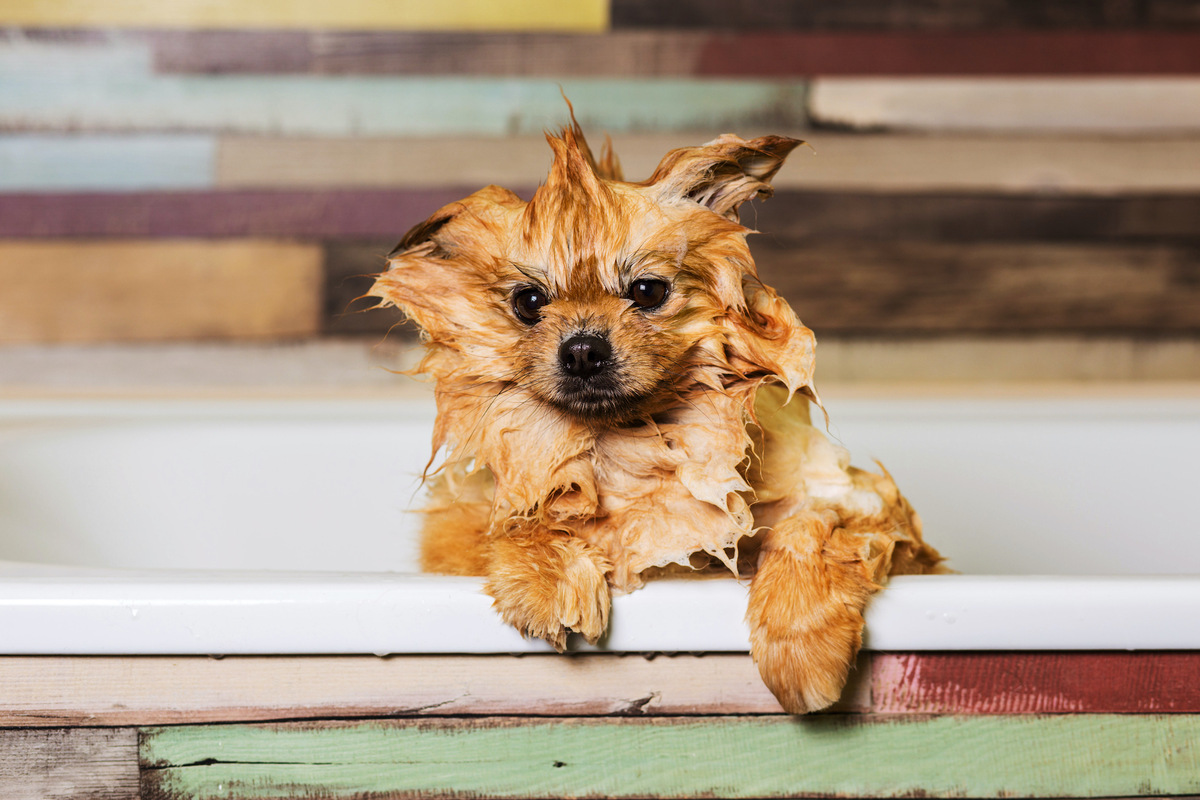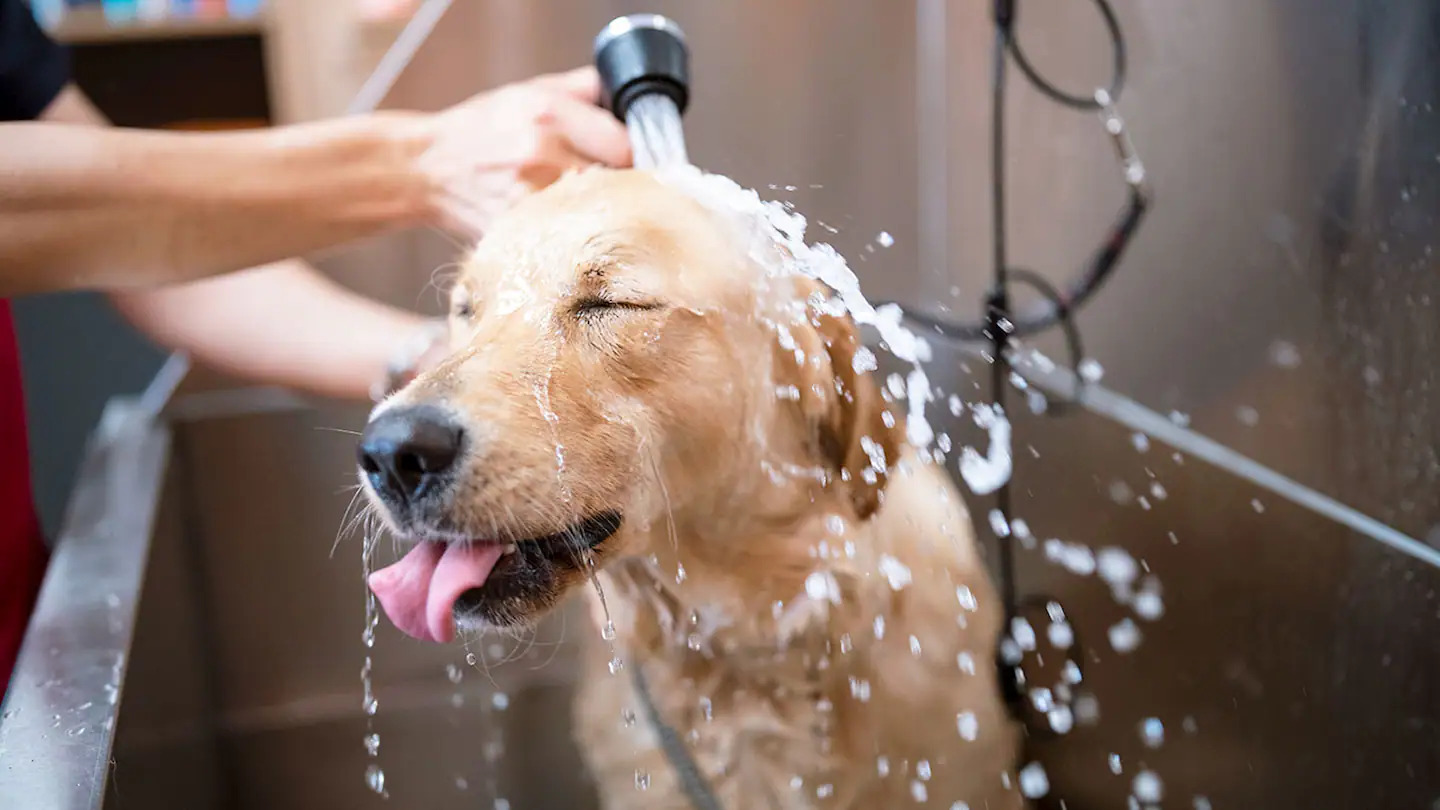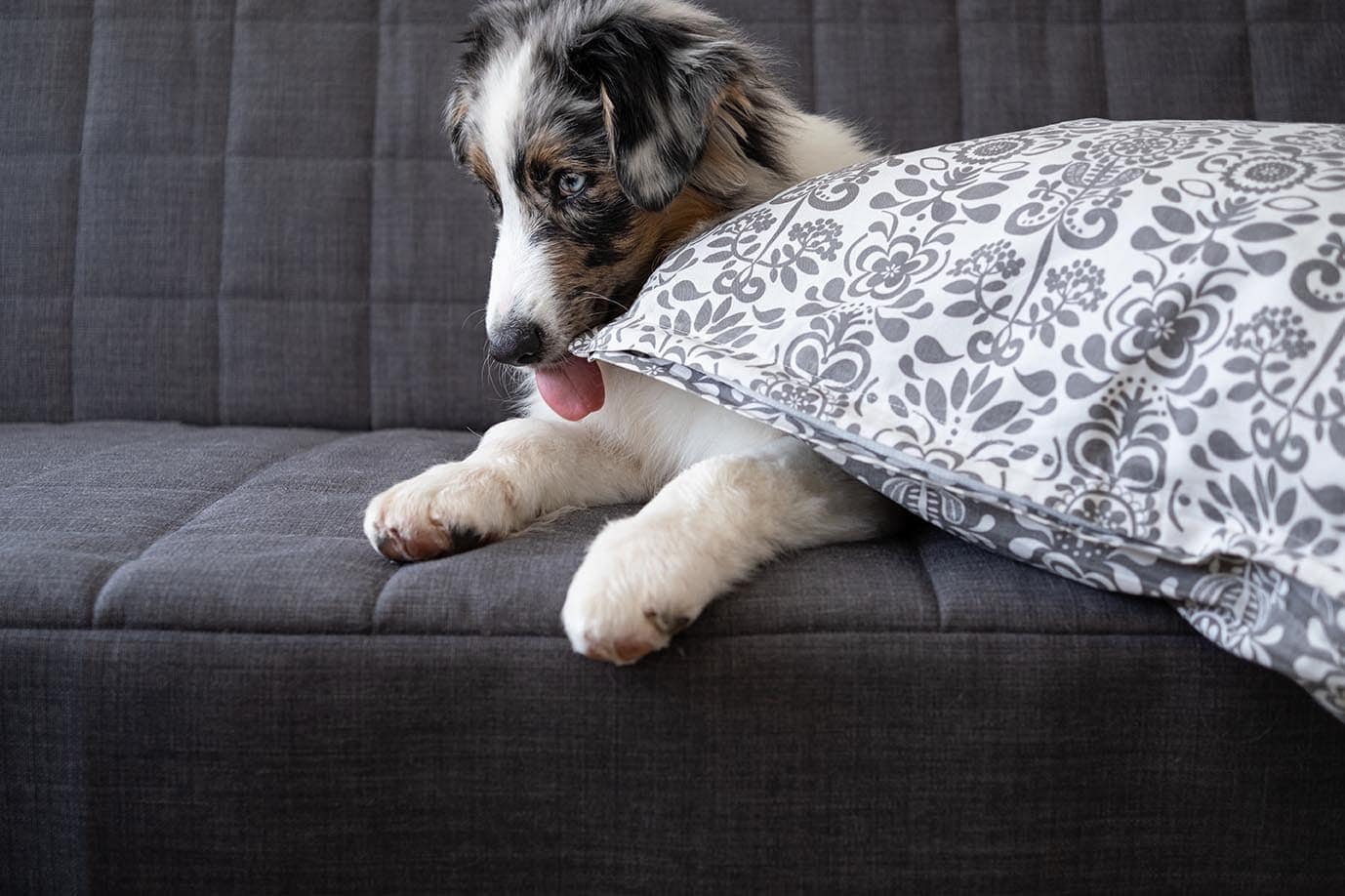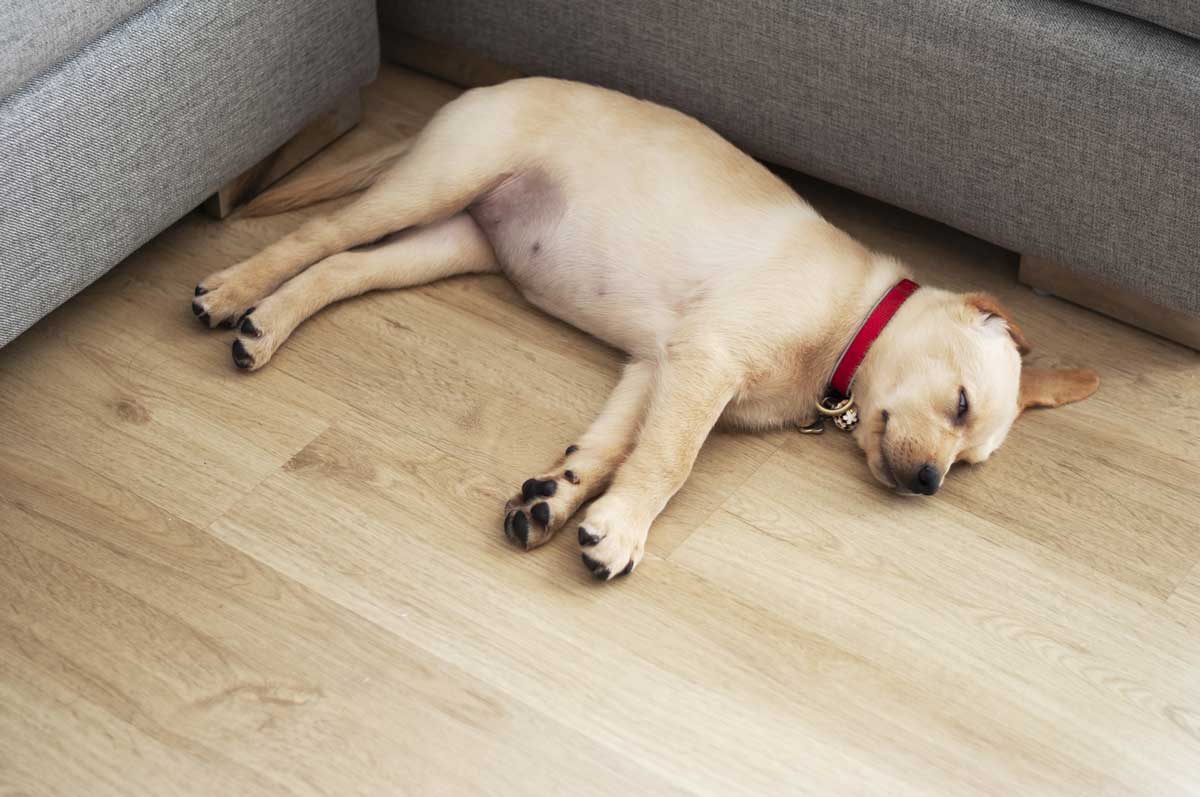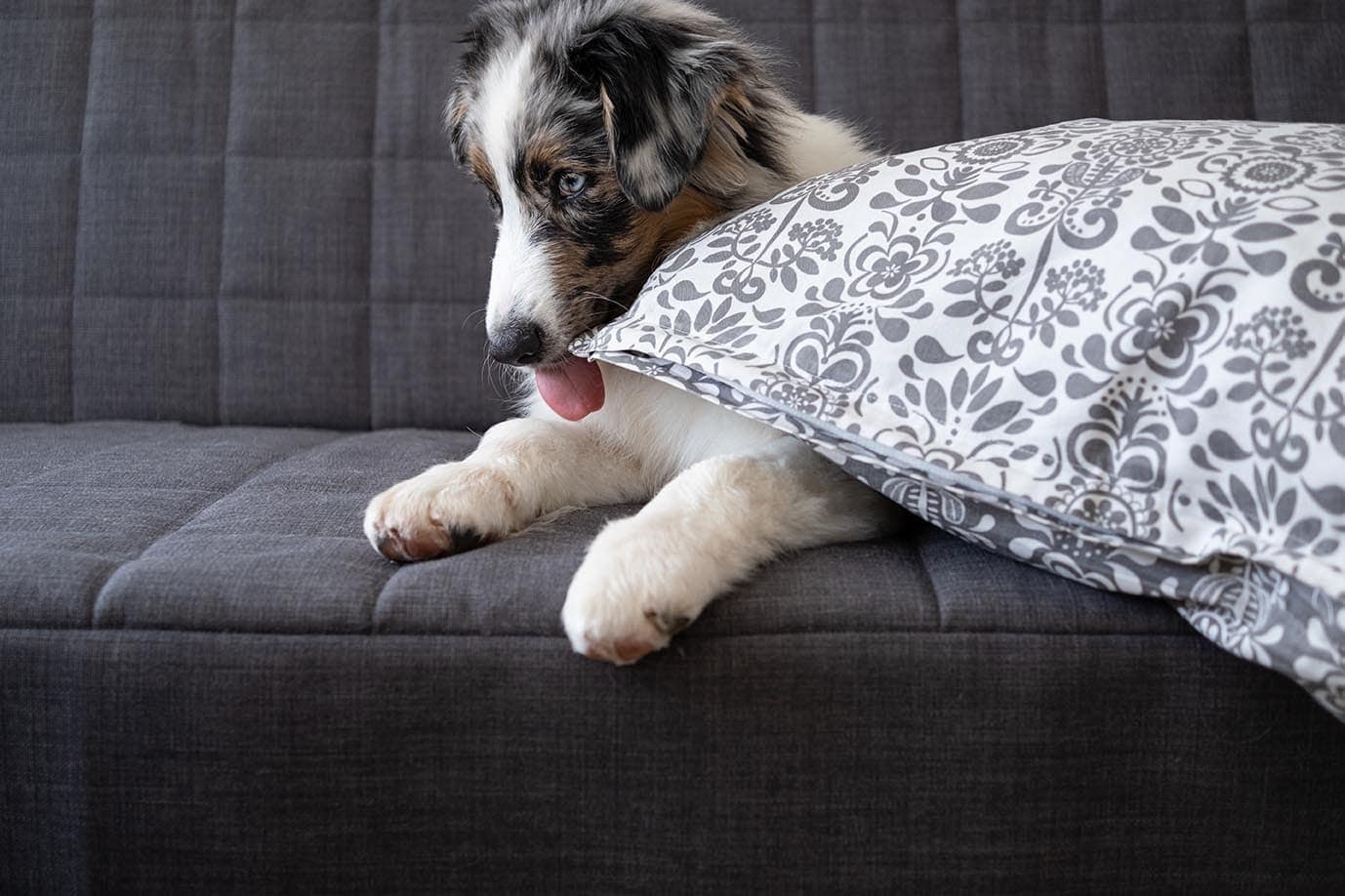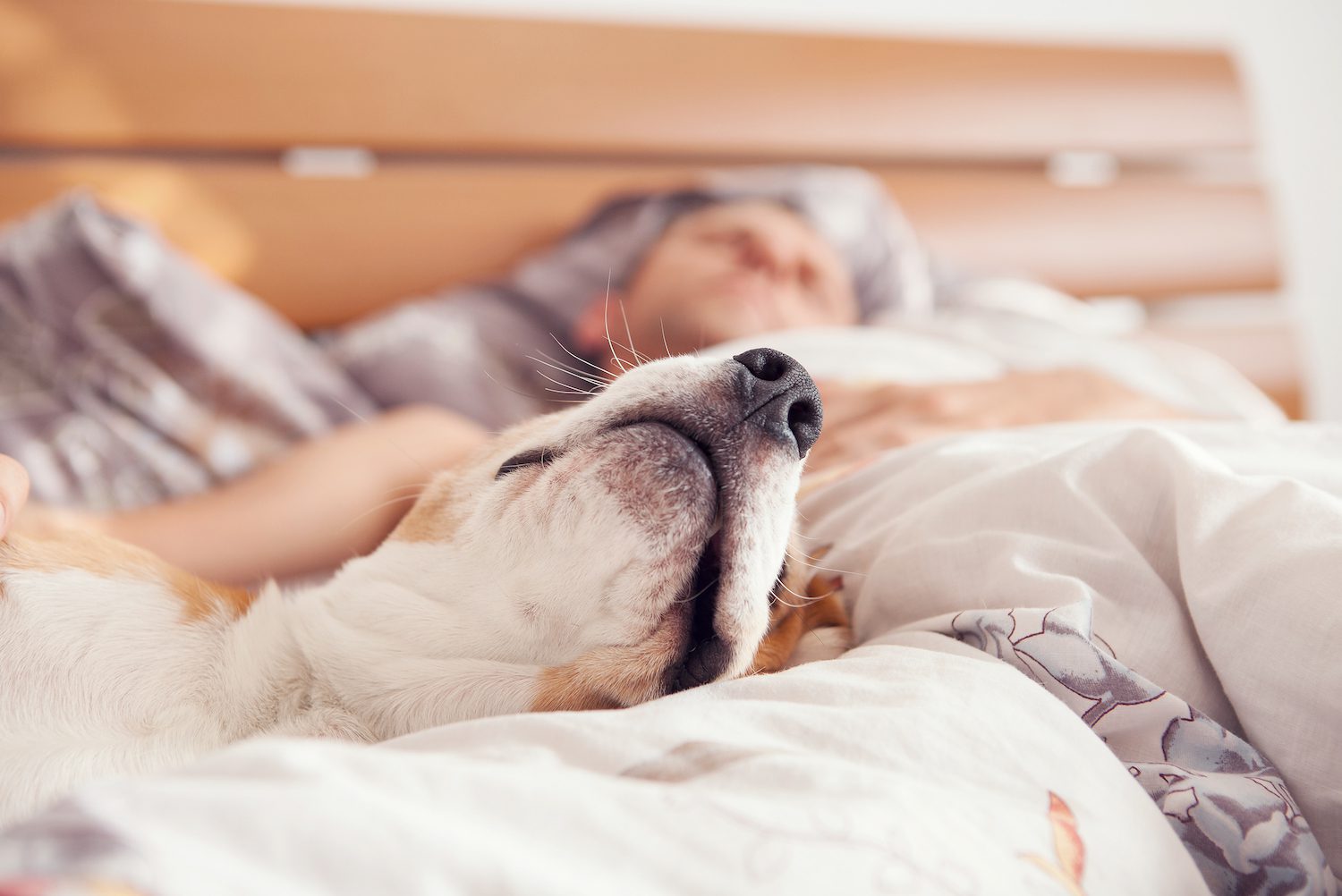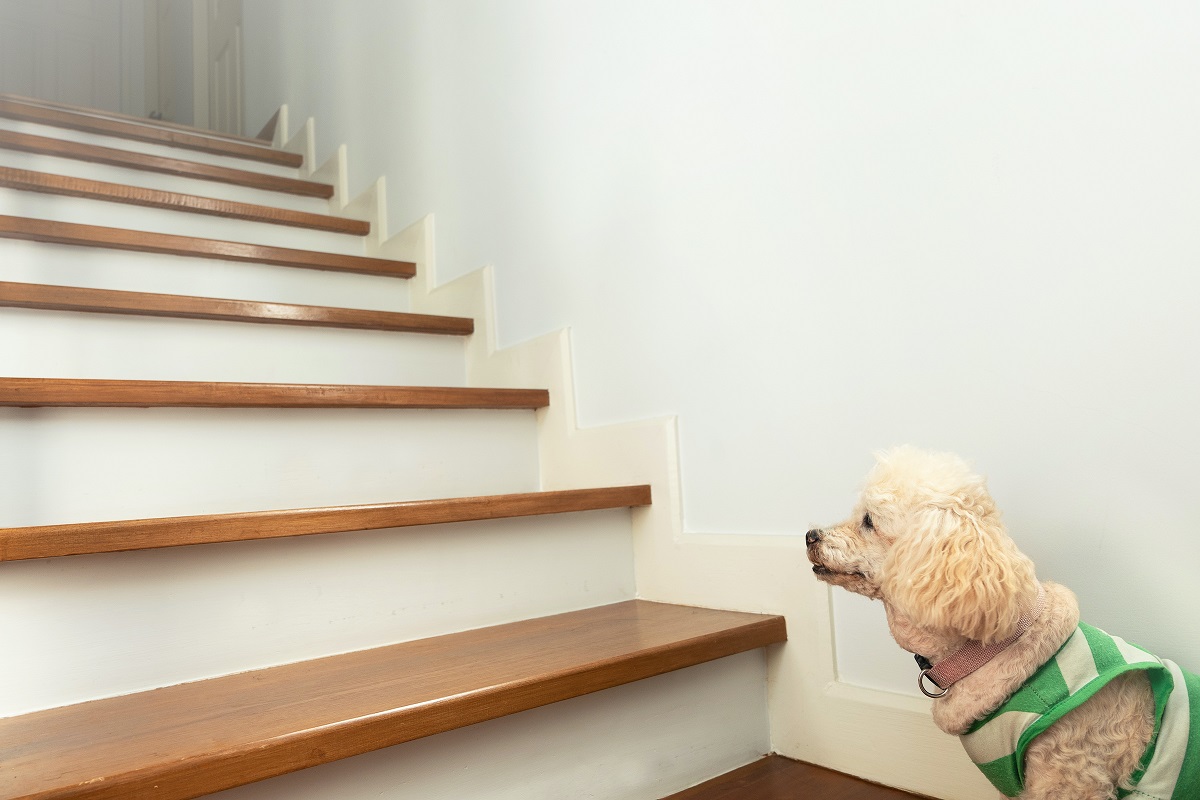Home>Furniture>Bedroom Furniture>Why Does My Dog Hide Under The Bed
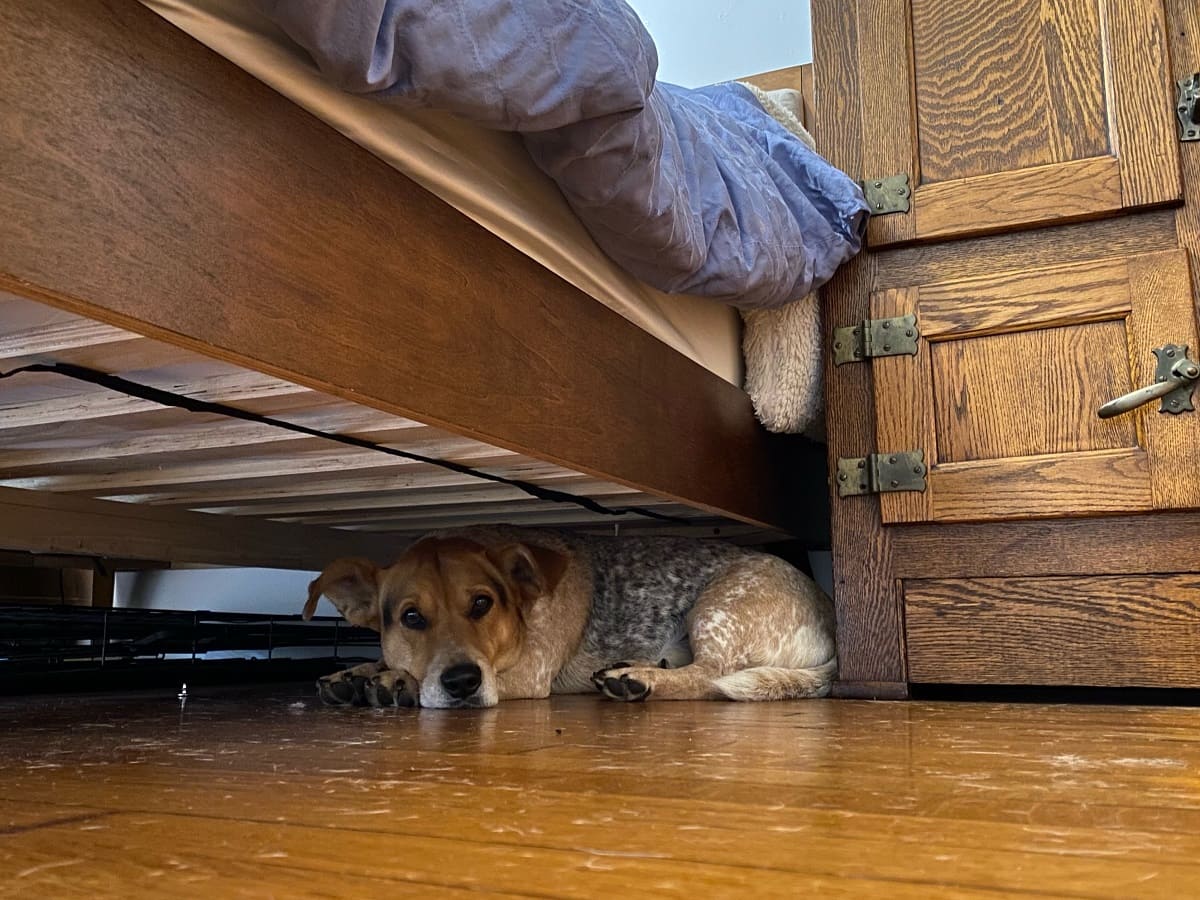

Bedroom Furniture
Why Does My Dog Hide Under The Bed
Published: December 7, 2023
Discover the reasons why your dog hides under the bed and learn how to create a comforting and secure bedroom furniture environment for your furry friend.
(Many of the links in this article redirect to a specific reviewed product. Your purchase of these products through affiliate links helps to generate commission for Storables.com, at no extra cost. Learn more)
Introduction
Have you ever walked into your bedroom only to find your furry friend hiding under the bed? It may be a common sight for dog owners, but have you ever wondered why dogs have this tendency to seek refuge under the bed? It turns out that there are several reasons why dogs exhibit this behavior, and understanding them can help you provide the necessary support and comfort to your canine companion.
In this article, we will delve into the common reasons why dogs hide under the bed and explore strategies to help them feel safe outside of this cozy hiding spot. From fear and anxiety to seeking comfort and security, there are various factors that can contribute to your dog’s desire to hide under the bed. By gaining insight into these reasons and implementing appropriate techniques, you can create a supportive environment that promotes your dog’s well-being.
So, why does your dog choose to retreat under the bed? Let’s find out!
Key Takeaways:
- Dogs hide under the bed due to fear, seeking comfort, avoiding noise, medical issues, past trauma, or separation anxiety. Understanding these reasons helps provide support and create a safe environment for our furry companions.
- Strategies such as gradual exposure, positive reinforcement, environmental enrichment, and professional help can help dogs feel safe and secure outside of the bed. By addressing their emotions and providing the necessary support, we can help our furry friends lead happy and fulfilling lives.
Read more: Why Does My Dog Like Sleeping Under The Bed
Common Reasons Dogs Hide Under the Bed
There are several common reasons why dogs choose to hide under the bed. Understanding these reasons can help you address any underlying issues and provide the necessary support for your furry friend. Here are some of the most common reasons:
- Fear or Anxiety: Dogs may hide under the bed as a response to fear or anxiety. This can be triggered by various factors, such as loud noises, thunderstorms, fireworks, or unfamiliar visitors. The enclosed space under the bed provides them with a sense of security and helps them cope with their anxious feelings.
- Seeking Comfort or Security: Dogs are den animals by nature, and seeking out small, enclosed spaces is instinctual for them. When they hide under the bed, they might be looking for a cozy and secure spot where they can feel protected. This behavior is similar to how wild dogs would dig a den or burrow for safety.
- Avoiding Noise or Disturbances: Dogs have sensitive hearing, and certain noises can be overwhelming for them. If there are loud sounds or disturbances in the environment, your dog may choose to hide under the bed as a means to escape or shield themselves from the noise and commotion.
- Medical Issues or Pain: Dogs may hide under the bed if they are experiencing physical discomfort or pain. This can be due to an injury, illness, or underlying medical condition. If you notice your dog consistently hiding under the bed accompanied by signs of discomfort or changes in behavior, it’s important to consult with your veterinarian to rule out any health issues.
- Past Traumatic Experiences: Dogs that have had past traumatic experiences, such as abuse or neglect, may exhibit a strong tendency to hide under the bed. It serves as a safe space where they can retreat and feel protected from potential threats. Patience, understanding, and positive reinforcement training can help dogs with a history of trauma overcome their fears and develop a sense of trust.
- Separation Anxiety: Dogs with separation anxiety may seek out the under-bed area when they are left alone. They may feel a sense of comfort and security in this confined space, helping them cope with the distress of being separated from their owners.
It’s important to remember that while hiding under the bed can be a coping mechanism for your dog, it should not be the only solution to address their underlying issues. By identifying the root cause and implementing appropriate strategies, you can help your dog feel safe and secure in other areas of your home as well.
Fear or Anxiety
Fear and anxiety are common emotions that dogs experience, and they can be significant factors that lead to hiding under the bed. Dogs can be sensitive to loud noises, unfamiliar environments, or certain triggers that make them feel threatened or scared. When faced with these situations, seeking the safety and comfort of the under-bed area provides them with a sense of security.
There are various reasons why dogs may experience fear or anxiety:
- Loud Noises: Dogs have sensitive hearing, and loud noises such as thunderstorms, fireworks, or construction sounds can trigger a fear response. The sudden and intense sounds can overwhelm dogs, causing them to seek refuge under the bed where they feel protected from the noise.
- Separation Anxiety: Dogs with separation anxiety can become anxious and distressed when separated from their owners. The under-bed area may serve as a comforting space where they can feel safe and secure in the absence of their human companions.
- Social Anxiety: Some dogs may experience anxiety in social situations, especially when encountering unfamiliar people or other animals. Hiding under the bed allows them to distance themselves from potential stressors, helping them feel more in control of their environment.
- Past Trauma: Dogs that have had traumatic experiences in the past, such as abuse or neglect, may develop fear or anxiety-related behaviors. Hiding under the bed can be a way for them to cope with their past traumas, as it provides a safe and protected space where they feel less vulnerable.
- Changes in Routine or Environment: Dogs are creatures of habit, and sudden changes in their routine or environment can trigger anxiety. This could include moving to a new home, introducing new family members or pets, or major renovations that disrupt their familiar surroundings. Hiding under the bed allows dogs to retreat to a familiar space when faced with these changes.
If your dog is showing signs of fear or anxiety and consistently seeks solace under the bed, there are strategies you can implement to help them feel more secure in various areas of your home. Gradual exposure, positive reinforcement, and creating a calm and supportive environment can all aid in helping your dog overcome their fears and reduce their need to hide under the bed.
Remember to consult with a professional if your dog’s anxiety or fear becomes severe or significantly impacts their daily life. They can provide guidance and tailored solutions to address your dog’s specific needs.
Seeking Comfort or Security
One of the common reasons why dogs hide under the bed is their innate desire for comfort and security. Dogs are den animals by nature, and seeking out small, enclosed spaces is instinctual for them. The under-bed area provides a cozy and protected space where they can feel safe and secure.
Here are some factors that contribute to dogs seeking comfort or security under the bed:
- Natural Instinct: Dogs have a natural instinct to seek out a den-like environment for safety and security. In the wild, dogs would dig burrows or find small, enclosed spaces to protect themselves from predators and harsh weather conditions. Under the bed mimics this instinctual behavior, providing a space where dogs can feel sheltered.
- Familiar Scent: Dogs have a highly developed sense of smell and are comforted by familiar scents. The bedding and surrounding area under the bed carry their scent, which helps them feel more at ease and secure in that space.
- Escape from Overstimulation: Dogs can sometimes become overwhelmed by excessive stimuli, such as noise, activity, or attention. Hiding under the bed allows them to escape from these overstimulating situations and find solace in a quieter and calmer environment. It serves as a retreat where they can recharge and regain their sense of balance.
- Protection from Danger: When dogs feel threatened or insecure, they often seek out areas where they can hide from potential dangers. Under the bed provides a vantage point that allows them to monitor their surroundings while feeling protected from any perceived threats.
- Privacy and Personal Space: Dogs, like humans, appreciate having their own personal space. The under-bed area offers them privacy and a designated spot that is solely theirs. It’s a space where they can relax, unwind, and retreat from the hustle and bustle of daily life.
If your dog consistently seeks comfort or security under the bed, it’s important to provide alternative spaces within your home that offer a similar sense of safety and security. Creating cozy dog beds or designated quiet corners with blankets can offer your dog additional options for comfort. Gradually introducing your dog to these alternative spaces and using positive reinforcement, such as treats and praise, can help them form positive associations and reduce their reliance on hiding under the bed.
Remember, every dog is unique, and their preferences for seeking comfort and security may vary. Pay attention to your dog’s behavior and provide them with a range of options to ensure they have a safe and comfortable space throughout your home.
Avoiding Noise or Disturbances
Noise sensitivity is a common trait among dogs, and they can become overwhelmed or distressed by loud sounds or disturbances in their environment. When faced with these situations, dogs may instinctively seek refuge under the bed to escape or shield themselves from the noise.
Here are some reasons why dogs may hide under the bed to avoid noise or disturbances:
- Loud Noises: Dogs have acute hearing, and certain noises can be particularly unsettling for them. Thunderstorms, fireworks, vacuum cleaners, or even construction sounds can trigger fear or anxiety in dogs. The under-bed area provides a quiet and enclosed space where they can minimize the impact of loud noises and feel more secure.
- Unfamiliar Visitors: Dogs may become apprehensive or wary in the presence of unfamiliar people or animals. When faced with visitors or guests, they may seek the under-bed area as a means to avoid direct contact and observe from a safe distance.
- High Activity or Energy: Dogs can become overstimulated in high-energy environments, especially if there is a lot of movement or commotion happening around them. Hiding under the bed allows them to retreat to a calmer and less stimulating space where they can relax and feel more at ease.
- Predatory Instincts: Some dogs may exhibit a strong prey drive and react sensitively to fast movements or loud noises that resemble potential threats. Hiding under the bed allows them to minimize exposure to stimuli that trigger their instinctual response, helping them feel safer and in control.
- Barking or Excitable Dogs: If you have other dogs in your household that tend to bark or display excitable behavior, it may make your dog feel uneasy or overwhelmed. In such cases, hiding under the bed can serve as a way for them to distance themselves and find solace away from the chaos.
If your dog consistently seeks refuge under the bed to avoid noise or disturbances, it is important to create a calm and peaceful environment for them. Identifying the specific triggers that cause your dog to feel anxious or fearful and implementing strategies to minimize their exposure to those stimuli can be helpful. For example, during thunderstorms, you can create a cozy and soundproofed area for your dog with comforting music or white noise to help drown out the loud sounds.
Gradual desensitization can also be an effective technique to help your dog become more comfortable with noises that trigger their anxiety. By exposing them to low levels of the triggering sound and gradually increasing the volume or intensity over time, you can help them build resilience and reduce their need to seek refuge under the bed.
Remember, each dog has unique sensitivities and preferences, so it is important to be patient and understanding. Providing a safe and nurturing environment and using positive reinforcement techniques can help your dog navigate their sensitivity to noise and disturbances in a more confident manner.
Read more: Why Does My Dog Like To Sleep On My Bed
Medical Issues or Pain
Hiding under the bed can also be a sign that your dog is experiencing medical issues or pain. When dogs are not feeling well, they often seek out isolated and secluded areas as a way to cope with their discomfort. Here are some reasons why dogs may hide under the bed due to medical issues or pain:
- Injury or Illness: Dogs may instinctively retreat to the under-bed area if they have sustained an injury or are suffering from an illness. They may feel vulnerable and prefer the privacy and security provided by this enclosed space.
- Chronic Pain: Dogs that suffer from chronic conditions such as arthritis, hip dysplasia, or back problems may find relief by hiding under the bed. The cool and supportive surface of the floor can offer them some comfort and alleviate their pain temporarily.
- Postoperative Recovery: If your dog has recently undergone surgery or a medical procedure, they may seek solace under the bed during their recovery period. The confined space can provide a sense of security and help them rest and heal.
- Underlying Medical Conditions: Some medical conditions can cause dogs to experience pain or discomfort, leading them to hide under the bed. This could include gastrointestinal issues, urinary tract infections, or dental problems. It’s important to observe your dog’s behavior closely and consult with a veterinarian if you suspect any underlying health concerns.
- Side Effects of Medications: Certain medications can cause dogs to feel lethargic or drowsy, prompting them to seek out quiet and peaceful areas to rest. Under the bed may provide a serene space where they can retreat and recover from the effects of their medication.
If you notice that your dog is consistently hiding under the bed and displaying signs of pain or discomfort, it is crucial to consult with your veterinarian. They can perform a thorough examination, conduct diagnostic tests if necessary, and develop a treatment plan to address your dog’s medical issues or pain.
Providing your dog with a comfortable and supportive environment is essential during their recovery process. Consider creating a designated recovery area with soft bedding, easy access to food and water, and minimal distractions. This will help ensure that they have a safe and calm space to rest and heal.
Always follow your veterinarian’s recommendations and administer any prescribed medications or treatments as instructed. By addressing your dog’s medical issues or pain, you can help improve their overall well-being and reduce their need to hide under the bed for relief.
Past Traumatic Experiences
Past traumatic experiences can have a profound impact on a dog’s behavior and their willingness to trust their environment and people. Dogs that have experienced abuse, neglect, or other traumatic events may often seek refuge under the bed as a coping mechanism. Here are some reasons why dogs may hide under the bed due to past traumatic experiences:
- Fear and Anxiety: Dogs that have been subjected to traumatic events may develop deep-rooted fear and anxiety. Hiding under the bed provides them with a sense of security and control, allowing them to retreat from potential threats and triggers that remind them of their past traumatic experiences.
- Trust Issues: Dogs that have been mistreated or neglected may have difficulty trusting humans. They may see the under-bed area as a safe space where they can avoid interactions and limit their vulnerability.
- Hyper-Vigilance: Dogs with a history of trauma may be hyper-vigilant in their surroundings, constantly on alert for any signs of danger. Hiding under the bed enables them to monitor their environment while feeling protected from potential threats.
- Recovery and Healing: When dogs are on the path to recovery and healing after a traumatic experience, they may seek solitude and isolation. The under-bed area can serve as a refuge where they can process their experiences and gradually build trust in a calm and controlled space.
- Regression: Dogs that have made progress in their recovery journey may occasionally regress and seek comfort under the bed. This behavior is normal and reflective of their ongoing healing process. It’s important to provide patience, understanding, and gentle encouragement during these times.
If your dog has a history of trauma and consistently hides under the bed, it’s crucial to approach their healing process with patience and compassion. Building trust and providing a secure environment is key to helping them overcome their past traumas. Give them ample time and space to adjust, and avoid forcing them out of their hiding spot as this may further reinforce their fear or anxiety.
Positive reinforcement training can be highly beneficial in helping traumatized dogs build confidence and trust. Rewarding them for calm and courageous behavior, even if it’s just stepping out from under the bed for a brief moment, can gradually instill a sense of trust and safety.
Consider seeking the assistance of a professional dog behaviorist or trainer experienced in working with traumatized dogs. They can provide expert guidance and design a personalized plan to help your dog overcome their past traumas and gradually reduce their need to hide under the bed.
Remember, each dog’s healing process is unique, and it may take time for your dog to fully recover and regain their trust in their surroundings. By providing patience, love, and support, you can help your dog feel safe and secure, and gradually reduce their reliance on hiding under the bed as a coping mechanism.
Ensure your dog has a safe space, like a crate or bed, where they feel secure. Provide positive reinforcement when they come out from under the bed to build confidence.
Separation Anxiety
Separation anxiety is a common behavioral issue that many dogs experience when they are separated from their owners. Dogs with separation anxiety often exhibit destructive or anxious behaviors in an attempt to cope with their distress. Hiding under the bed can be a common behavior exhibited by dogs with separation anxiety. Here are some reasons why dogs with separation anxiety may hide under the bed:
- Comfort and Security: Dogs with separation anxiety find comfort and security in small, enclosed spaces. The under-bed area provides a cozy and secluded spot where they can feel safe and protected while their owners are away.
- Reducing Stimulation: Dogs with separation anxiety may become overwhelmed by the stimuli in their environment. Hiding under the bed allows them to escape or minimize exposure to external sounds, sights, and smells, thus reducing their anxiety levels.
- Coping with Loneliness: Dogs with separation anxiety may feel intense loneliness and distress when left alone. Hiding under the bed can serve as a way for them to cope with these emotions by seeking solace in a space that smells familiar and feels secure.
- Avoiding Abandonment: Dogs with separation anxiety often fear being abandoned by their owners. Hiding under the bed can help them feel more in control and reduce their fear of being left alone.
- Creating a Den-like Environment: Underneath the bed can resemble a den-like environment that dogs instinctively seek for security. It provides them with a confined space where they can feel safe and protected, mimicking the denning behavior of their wild ancestors.
If your dog shows signs of separation anxiety and consistently hides under the bed, there are strategies you can implement to help alleviate their distress:
- Gradual Desensitization: Gradually increasing the duration of time you spend away from your dog can help them develop confidence and reduce their anxiety. Start with short periods of separation and gradually extend the time, rewarding your dog for calm behavior.
- Creating a Safe Space: Designate a specific area in your home where your dog feels safe and secure. This can be a crate, a cozy corner with their bed and toys, or a designated room with comforting scents and soothing music.
- Calming Techniques: Incorporate calming techniques, such as using pheromone diffusers or playing gentle music, to create a calming and soothing environment for your dog. These can help reduce their anxiety levels and promote relaxation.
- Positive Reinforcement: Reward your dog with praise, treats, or toys whenever they exhibit calm behavior, both during your absence and when they emerge from under the bed. This positive reinforcement can help build their confidence and encourage them to gradually rely less on hiding under the bed.
- Professional Help: If your dog’s separation anxiety persists or worsens despite your efforts, consider seeking guidance from a professional dog trainer or veterinary behaviorist. They can provide tailored strategies and techniques to address your dog’s specific needs.
Remember, addressing separation anxiety requires patience, consistency, and understanding. With time, training, and a supportive environment, you can help your dog overcome their separation anxiety and reduce their need to hide under the bed as a coping mechanism.
Strategies to Help Your Dog Feel Safe Outside of the Bed
While hiding under the bed may provide comfort and security for your dog, it’s important to help them feel safe and relaxed in other areas of your home as well. Here are some strategies to encourage your dog to explore and feel secure outside of the bed:
- Gradual Exposure and Positive Reinforcement: Gradually introduce your dog to different areas of your home, starting with quiet and low-stimulus areas. Use positive reinforcement techniques such as treats, praise, and play to reward them for exploring and spending time in these areas. This will help them associate positive experiences with these spaces.
- Environmental Enrichment and Mental Stimulation: Provide your dog with plenty of mental and physical stimulation throughout the day. Engage in interactive play sessions, offer puzzle toys or treat-dispensing toys, and provide opportunities for exploration and sniffing during walks. Mental stimulation and exercise can help reduce anxiety and increase confidence.
- Comforting Scents: Place familiar bedding or clothing with your scent in areas where you want your dog to feel secure. Your scent can provide reassurance and make them feel more comfortable in those spaces.
- Create Cozy Spaces: Set up comfortable and cozy spots around your home where your dog can relax. Use soft blankets, dog beds, or even a designated crate with an open door. These spaces can provide a sense of comfort and security, similar to the under-bed area.
- Use Calming Products: Consider using calming aids such as pheromone diffusers, essential oils, or natural calming supplements. These products can help create a soothing environment and promote relaxation for your dog.
- Positive Associative Training: Use positive reinforcement training techniques to help your dog associate positive experiences with different areas of your home. Reward them with praise, treats, or play whenever they voluntarily explore or spend time in these areas to reinforce their confidence and comfort.
- Create a Routine: Establishing a consistent routine can help your dog feel more secure and reduce anxiety. Stick to regular feeding times, exercise schedules, and predictable patterns of daily activities. This familiarity can provide a sense of stability and security for your dog.
- Seek Professional Help: If your dog continues to struggle with feeling safe outside of the bed despite your efforts, consider consulting a professional dog trainer or veterinary behaviorist. They can provide personalized guidance and develop a behavior modification plan tailored to your dog’s needs.
Remember, be patient and understanding with your dog’s progress. Each dog is unique, and it may take time for them to feel comfortable and secure in different areas of your home. By implementing these strategies and providing a supportive and nurturing environment, you can help your dog overcome their reliance on hiding under the bed and promote their overall well-being.
Read more: Why Does My Dog’s Pee Turn The Grass Yellow
Gradual Exposure and Positive Reinforcement
Gradual exposure and positive reinforcement are essential strategies to help your dog feel safe and secure outside of the bed. By slowly introducing your dog to different areas of your home and rewarding them for calm and confident behavior, you can gradually build their trust and reduce their reliance on hiding. Here’s how you can utilize gradual exposure and positive reinforcement:
1. Start with Low-Stimulus Areas: Begin by introducing your dog to quiet and low-stimulus areas of your home. These areas should be free from loud noises, excessive foot traffic, or other potential stressors. Allow your dog to explore at their own pace, sniffing and investigating their surroundings.
2. Use Treats and Positive Reinforcement: Whenever your dog voluntarily explores or spends time in these areas, reward them with treats, praise, and gentle petting. Positive reinforcement creates positive associations and builds their confidence in those spaces. Make sure to give the reward immediately after the desired behavior to strengthen the connection.
3. Gradually Increase Exposure: Over time, gradually increase the duration and frequency of your dog’s exposure to these areas. Encourage them to spend more time exploring and feeling comfortable in each space. Pay attention to their body language and pacing to ensure they are not becoming overwhelmed.
4. Progress to More Stimulating Areas: Once your dog feels comfortable in low-stimulus areas, gradually introduce them to more stimulating environments. This could include spaces with moderate activity or mild distractions. Repeat the same process of positive reinforcement, rewarding calm and confident behavior.
5. Monitor and Adjust: Observe your dog’s reactions and behavior during each exposure session. If they seem anxious or overwhelmed, take a step back and return to a less stimulating area. Every dog has different thresholds, and it’s important to proceed at a pace that is comfortable for them.
6. Create Positive Associations: Make these areas a positive and enjoyable experience for your dog. Incorporate their favorite toys, interactive play, or relaxation exercises in these spaces. By associating positive and enjoyable activities with these areas, your dog will be more likely to seek them out voluntarily.
7. Be Patient and Consistent: Building trust and confidence takes time. Be patient with your dog’s progress and celebrate even small steps towards feeling safe outside of the bed. Consistency in training, positive reinforcement, and gradual exposure will yield the best results.
8. Seek Professional Help if Needed: If your dog has severe anxiety or if their progress is stagnant, consider seeking the guidance of a professional dog trainer or veterinary behaviorist. They can assess your dog’s specific needs and provide expert advice and tailored strategies to help your dog overcome their fear or anxiety.
Remember, every dog progresses at their own pace. By consistently using gradual exposure and positive reinforcement techniques, you can help your dog feel more secure and confident throughout your home, reducing their need to hide under the bed.
Environmental Enrichment and Mental Stimulation
Environmental enrichment and mental stimulation are vital for keeping your dog physically and mentally engaged, which can help them feel more secure and content outside of the bed. By providing opportunities for exploration, play, and mental exercise, you can help alleviate boredom and anxiety. Here’s how you can incorporate environmental enrichment and mental stimulation into your dog’s daily routine:
1. Interactive Toys: Introduce interactive toys that require your dog to problem-solve and work for their treats or rewards. Puzzle toys, treat-dispensing balls, or Kong toys filled with delicious treats can keep your dog mentally engaged and occupied, redirecting their focus away from hiding under the bed.
2. Scent Games: Engage your dog’s sense of smell by hiding treats or toys throughout different areas of your home. This encourages them to use their natural sniffing abilities and provides mental stimulation as they search for hidden treasures. Gradually increase the difficulty level of the hiding spots to keep them challenged.
3. Training Sessions: Regular training sessions not only teach your dog new skills but also provide mental exercise and strengthen the bond between you. Use positive reinforcement techniques to teach your dog basic commands or fun tricks. This mental stimulation can help boost their confidence and overall well-being.
4. Daily Walks and Exercise: Regular exercise, especially outdoor walks, provides both physical and mental stimulation for your dog. Exploring new scents, sights, and sounds during walks can keep their minds engaged, helping to reduce anxiety and destructive behaviors. Aim for consistent daily exercise to help your dog expend energy and stay mentally stimulated.
5. Rotation of Toys: Rotate your dog’s toys regularly to maintain their interest and prevent boredom. Keep a few toys accessible at a time and switch them out periodically. This keeps their environment dynamic and exciting, encouraging them to explore and engage with their toys rather than seeking comfort under the bed.
6. Interactive Playtime: Engage in interactive play sessions with your dog using toys like tug ropes, squeaky toys, or balls. This type of play not only provides exercise but also strengthens the bond between you and your dog. It allows them to engage their minds and focus their energy on playful interactions with you.
7. Provide Chewing Opportunities: Dogs have an innate need to chew, which can help relieve stress and anxiety. Offer them appropriate chew toys or treats to satisfy their chewing instinct. This not only provides mental stimulation but also helps keep their teeth healthy.
8. Create a Safe Outdoor Space: If possible, provide a secure and supervised outdoor space where your dog can explore and interact with their environment. This can include a fenced yard or a designated play area. Outdoor exploration can greatly enrich your dog’s life and stimulate their senses.
Remember to tailor environmental enrichment and mental stimulation activities to your dog’s individual preferences and energy levels. Providing a variety of engaging and challenging experiences can help your dog feel more fulfilled and less inclined to hide under the bed. Mix and match different activities to create a stimulating and enriching environment for your canine companion.
Assisting with Fear and Anxiety
If your dog experiences fear and anxiety, it’s important to provide them with comfort and support. Understanding their triggers and employing appropriate techniques can help alleviate their anxiety and reduce the need to hide under the bed. Here are some strategies to assist your dog with fear and anxiety:
1. Create a Safe Space: Designate a quiet and comfortable area in your home where your dog can retreat when they feel anxious. This can include a cozy corner with their bed, blankets, and toys. Ensure that this space is free from any potential stressors and provide access to their favorite items for added comfort.
2. Calming Music or Sounds: Play calming music or use white noise machines to help drown out noises that may trigger your dog’s anxiety. These soothing sounds can create a more peaceful environment and help them relax.
3. Maintain a Consistent Routine: Dogs thrive on routine and predictability. Establish a daily routine for feeding, exercise, and bedtime to help your dog feel secure and reduce anxiety levels. Consistency can provide them with a sense of stability and comfort.
4. Counter-Conditioning and Desensitization: If your dog has specific triggers that cause fear or anxiety, such as loud noises or unfamiliar situations, you can gradually expose them to these triggers in a controlled and positive way. By gradually increasing their exposure while providing treats, praise, and reassurance, you can help them associate the triggers with positive experiences, ultimately reducing their anxiety response.
5. Use Calming Supplements or Remedies: Consult with your veterinarian about natural calming supplements or remedies that could help reduce your dog’s anxiety. These can include herbal supplements, pheromone diffusers, or anxiety wraps. However, always consult with a professional before administering any medications or supplements to your dog.
6. Avoid Punishment: Punishment can increase your dog’s anxiety and fear, making their behavior worse. Instead, focus on positive reinforcement and reward-based training. Reward calm and relaxed behavior, and avoid reinforcing fearful reactions.
7. Provide Physical and Mental Exercise: Regular exercise and mental stimulation can help reduce anxious behaviors by burning off excess energy and providing an outlet for stress. Engage your dog in daily walks, play sessions, and mental enrichment activities to keep their minds occupied and help them relax.
8. Seek Professional Guidance: If your dog’s fear and anxiety persist or worsen despite your efforts, it may be beneficial to consult with a professional dog trainer or veterinary behaviorist. They can provide a specialized behavior modification plan, offer additional guidance, and address any underlying issues that may be contributing to your dog’s anxiety.
Remember, every dog is unique, and what works for one may not work for another. Be patient and compassionate with your dog as they work through their anxieties. With understanding, support, and appropriate strategies, you can help your dog overcome their fears and find comfort outside of the bed.
Professional Help and Support
When dealing with complex behavioral issues or severe anxiety in dogs, seeking professional help and support can provide invaluable guidance and expertise. A professional dog trainer or veterinary behaviorist can assess your dog’s specific needs and develop a customized plan to address their fears, anxieties, and hiding behaviors. Here’s how professional help can assist you and your dog:
1. Expert Assessment: A professional can conduct a thorough assessment of your dog’s behavior, triggers, and overall well-being. They have the expertise to identify underlying factors contributing to your dog’s fear, anxiety, or hiding tendencies.
2. Personalized Behavior Modification Plan: Based on their assessment, a professional can design a personalized behavior modification plan to address your dog’s specific needs. This plan may include gradual exposure techniques, counter-conditioning exercises, and management strategies tailored to your dog’s individual situation.
3. Guided Implementation: A professional can guide you through the implementation of the behavior modification plan. They will teach you the necessary techniques to help your dog overcome their fears, reduce anxiety, and feel more secure outside of the bed.
4. Support and Monitoring: Throughout the process, a professional can provide ongoing support and monitoring. They can assess your dog’s progress, adjust the training plan as needed, and provide guidance on any challenges you may encounter along the way.
5. Behavior Medication Management: In some cases, behavior medication prescribed by a veterinarian may be necessary to help alleviate severe anxiety or fear in dogs. A veterinary behaviorist can evaluate your dog’s individual needs and prescribe appropriate medication if deemed necessary.
6. Multimodal Approach: Professionals often take a multimodal approach, combining behavior modification techniques with other interventions such as pheromone therapy, herbal remedies, or referral for additional medical evaluations if needed. They can coordinate with your veterinarian to ensure a comprehensive approach to your dog’s well-being.
7. Addressing Underlying Health Issues: Sometimes, underlying health issues can contribute to fear, anxiety, or hiding behavior in dogs. A professional can work with your veterinarian to rule out any medical conditions that may be affecting your dog’s behavior and provide appropriate referrals for further evaluation or treatment if necessary.
8. Emotional Support for the Owner: Dealing with a dog with fear or anxiety can be challenging and emotionally draining for the owner. Professionals can provide guidance, empathy, and emotional support to help you navigate the process and maintain a positive mindset during your dog’s behavior modification journey.
Remember, professional help should always be sought from individuals with proper credentials, such as certified dog trainers or board-certified veterinary behaviorists. They have the knowledge and experience to address complex behavioral issues and can provide the guidance and support you and your dog need to overcome fear, anxiety, and hiding behaviors.
Read more: Why Does My Dog Lick Furniture
Conclusion
Hiding under the bed is a common behavior displayed by dogs for various reasons, including fear, seeking comfort, avoiding noise, medical issues, past trauma, or separation anxiety. Understanding these underlying reasons is crucial for providing the necessary support and creating a safe environment for our furry companions.
By implementing strategies such as gradual exposure, positive reinforcement, environmental enrichment, and professional help, we can help our dogs feel safe and secure outside of the bed. Gradual exposure and positive reinforcement techniques allow dogs to build confidence and associate positive experiences with different areas of the house. Environmental enrichment and mental stimulation help keep their minds engaged, reduce anxiety, and prevent boredom.
Assisting dogs with fear and anxiety involves creating a safe space, employing calming techniques, maintaining a consistent routine, and seeking professional guidance if needed. Professional help and support from trained experts can provide an in-depth assessment, personalized behavior modification plans, and ongoing monitoring to address specific fears and anxieties.
Remember, every dog is unique, and it may take time and patience to help them overcome their fears and reduce their desire to hide under the bed. By understanding their needs, providing a secure and nurturing environment, and seeking professional advice when necessary, we can support our dogs in feeling safe throughout our homes.
Ultimately, our goal is to create an environment where our dogs can flourish, feel loved, and thrive. By addressing their emotions, assisting with their fears, and providing the necessary support, we can help our furry friends lead happy and fulfilling lives outside of their cozy hiding spot under the bed.
Frequently Asked Questions about Why Does My Dog Hide Under The Bed
Was this page helpful?
At Storables.com, we guarantee accurate and reliable information. Our content, validated by Expert Board Contributors, is crafted following stringent Editorial Policies. We're committed to providing you with well-researched, expert-backed insights for all your informational needs.
